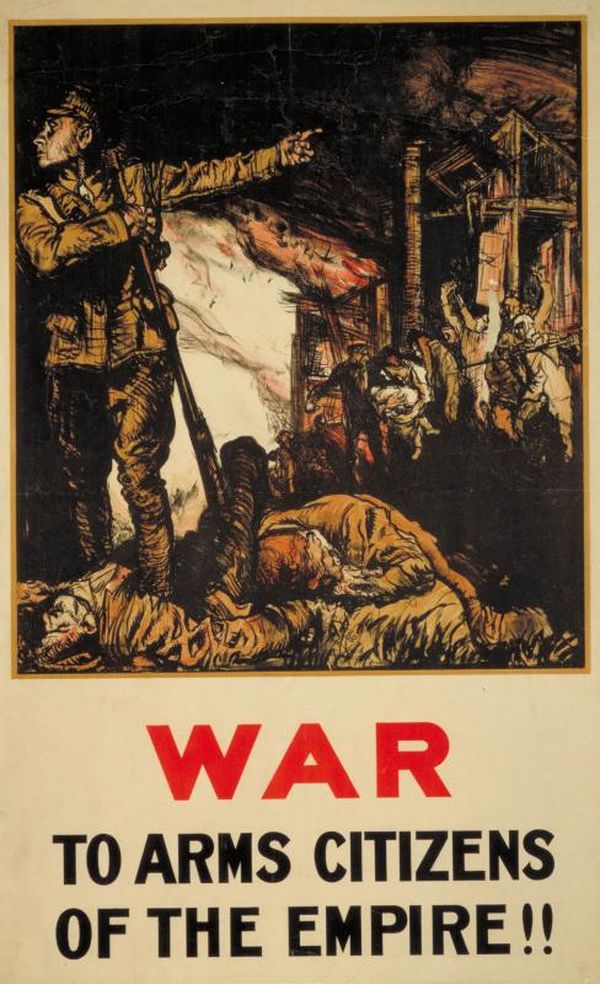
To Arms: 10 Underground posters of the First World War
Introduction
In the years leading up to the First World War, the Underground Group had begun using posters as a vital tool to promote the network. But as soon as the war broke out in 1914, Underground posters were also rapidly produced to publicise the war effort.
In the war’s early years, many were commissioned to encourage recruitment to the armed forces. Some were also used to relay news on the war’s progress to Londoners, with the Tube network providing ample advertising space. The Underground Group even produced posters to be displayed overseas to remind servicemen of home.
Here are ten Underground posters from the First World War.
When Britain declared war on 4 August 1914, it had a small army and needed to recruit men rapidly. This Frank Brangwyn design for the Underground uses his dramatic style to emphasise Germany’s destructive invasion of Belgium and northern France and to encourage men to join up. A British soldier gestures towards the smouldering wreckage of a town and its displaced and dead civilians.
This design also highlights the war’s early impact on civilians in Belgium and northern France in a graphic realism style similar to Brangwyn’s. According to contemporary accounts, Gerald Spencer Pryse witnessed this scene of British infantry marching through a shattered town, drawing directly onto lithographic stones from which the design was printed. He was provided with an Army staff car to carry the heavy stones.
As the war moved into 1915, Army recruitment was still essential and ongoing news of the war’s progress was anxiously followed. This Underground poster combines both these aspects in a standard format design, allowing space for changing photos and typed captions. At the very top it also features the distinctive ‘UndergrounD’ branding that had begun to be used in the early twentieth century, reflecting a more unified approach to promoting the network.
After the initial waves of men that flocked to the flag in 1914, voluntary enlistment began to dip in 1915. Posters like this one were used to try to sustain the number of volunteers, with this design typical in evoking the idea of the war as a grand sporting fixture between two mighty rivals. This poster is in the distinctive panel format unique to the London transport network, displayed above the seating in Tube train cars.
While the British Army was the main destination of most voluntary recruits, the Royal Navy was also vital to the British war effort. This poster was issued by the Underground Group on the Navy’s behalf, with Leonard Raven-Hill’s design depicting a determined and heroic looking seaman keeping a watchful eye over the threatening sea.
Unlike most of the recruitment posters produced by the Underground Group, this Fred Taylor design specifically references London transport companies. Set against a border using imagery of classical warriors, the Union Jack, a British Army soldier and a Royal Navy sailor, the central message uses the recruitment record of Underground railway companies to try to further bolster enlistment.
This bizarre 1915 poster both shows clear evidence of the war’s influence, yet wilfully asks Londoners to ignore it. Designed by the Warbis brothers for Easter 1915, it is typical of the majority of the Underground’s wartime pictorial posters in continuing to advertise leisure travel and transport services. But it does so in an exceptional and highly unusual way, by almost trivialising the war itself.
In 1916, Britain introduced compulsory conscription to the armed forces. With the need to assist recruitment over, the Underground Group began to commission posters intended to bolster the morale of troops serving overseas. This example by John Walter West, depicting women workers bringing in the harvest, reinforced the sense that the home front was supporting the efforts of those fighting overseas.
This George Clausen poster was one of a series produced from 1917 onwards intended solely for distribution overseas. Lettering at the top clearly stated how these posters were sent out by the Underground Group as ‘a reminder of home’ to troops serving abroad. The idyllic scenes of London’s surrounding countryside depicted in the posters was intended to brighten Army billets and military camps.
In 1918 a further four posters were commissioned from Emilio Tafani and Fred Taylor under the title ‘London Memories’, suggesting that the posters produced for overseas display had been well received. This Tafani example conveys the beauty of Wimbledon Common, a stark contrast to the artillery-scarred landscapes of the Western Front. Each of the four posters was marked with the message ‘With the compliments of the Underground Railways’ in the bottom right.
Some of the posters in this article can be seen in our London’s transport at war gallery






















